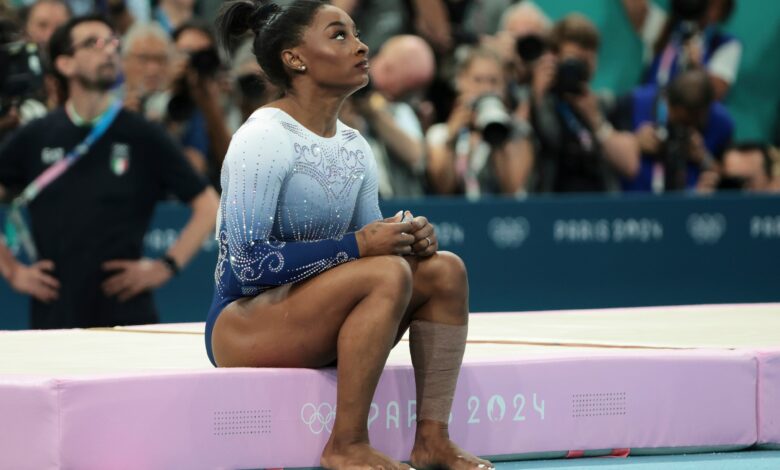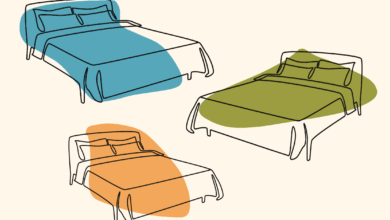Simone Biles’s Calf Injury at the Paris Olympics Was Even Worse Than It Seemed

If you eagerly followed the US women’s gymnastics team at the Paris Olympic Games last summer, you probably remember seeing Simone Biles’s calf wrapped in athletic tape as she limped, and at one point even crawled, across the competition floor. At the time, she didn’t divulge the specifics of her condition, nor did she let it prevent her from winning four medals. But in part two of her Netflix documentary Simone Biles Rising, released today, the 27-year-old phenom details the severity of her injury—and illuminates how much worse it could have been.
On day one of the women’s gymnastics qualifications in Paris, a nervous Biles took the floor to warm up. She and her teammates were given limited time, she recalled in episode three of the docuseries, and to be efficient, she wanted to “do the least amount.” So, she decided to do her iconic triple-double, also known as the Biles II, and as soon as she took off toward the vault, something in her lower leg went “shhhht,” as she put it.
“I was like, ‘Ooh, oh. That hurt really bad. That didn’t feel right. I just felt, like, a weird sensation in my calf muscle,” Biles told the cameras. As she hovered and twisted in the air, she feared that she had torn her Achilles tendon—the band of tissue that links your calf muscles to your heel bone. After all, just a few months prior at the 2024 Olympics Trials, she witnessed three leg injuries—two of which were Achilles-related—take her teammates Kayla DiCello, Skye Blakely, and Shilese Jones out of the running. Deep down, she always feared she was next. “Whenever something like that happens, you’re so terrified,” Biles said. “An injury can happen to any of us at any point.”
An Achilles tear is a sometimes career-ending injury that’s common among gymnasts. In fact, a 2021 study published in Sports Health found the risk of Achilles injuries to be 10 times higher in collegiate women’s gymnastics than in any other college sport. Research also suggests that the momentum-building run that launches gymnasts into floor exercises like vault and tumbling is most often the culprit of Achilles blows—and that’s exactly what Biles was doing when she felt her lower leg rip.
After hobbling off the mat in Paris, Biles and her team of coaches and medical experts were forced to make a big decision with little time to spare: Would she continue competing, or would she withdraw from the Games (and face backlash) as she did at the 2020 Tokyo Olympics after battling the “twisties”? Biles considered it an unwelcome “déjà vu” moment. “Ugh. It was so annoying. And I think that’s what irritated me the most,” she recalled. “As soon as I got off the floor, I was like, ‘People are gonna think I’m quitting again.’”
And she wasn’t willing to let that happen. So she pressed on and, for her remaining time in Paris, straddled the line between preparedness and overdoing it. Coaches monitored her stretching, she wore a compression sleeve on her calf, and Team USA Gymnastics’ physician Marcy Faustin, MD, helped manage her pain—which, thankfully, didn’t get worse throughout the rest of the Games. Her coach, Laurent Landi, ultimately told cameras that Biles was diagnosed with a calf “strain slash tear.”
While the extent of the injury may come as a surprise to Netflix viewers, Biles wasn’t exactly shocked. At 27, she is “old for a gymnast,” she said in the docuseries, and her body, she joked, is “a ticking time bomb.” She also shared that she dealt with a few minor injuries while training for Paris, including a hyperextended knee and a calf muscle tear—yep, in the exact same place it tore during qualifications. However, the second time around was worse: “Most of the time, I can still walk normally and do everything,” she explained while receiving physical therapy. “On every single punch and take off, I could definitely feel my calf,” she recalled later. “But we’re doing so much, you can’t really focus on it.”
Somehow, Biles managed to file the pain to the back of her mind and focus on performing, which is exactly what her coaches and “religious” therapy attendance, as she called it, primed her to do. She explained that she uses a mental health technique called visualization—which involves conjuring up soothing images like the sights and sounds of the beach—to calm herself if she’s “having trouble” while competing, which “really helps.” “I knew I could do it physically,” she added as her long-anticipated Olympic return came to a close. “The part that was hard for me was if I could last mentally.”
As we all know, Biles left Paris victorious with three gold medals (for the team all-around, individual vault, and individual all-around competitions) and one silver (for the individual floor). “I truly did try to enjoy each and every moment,” she said of the journey. “But we took it one day at a time, and for that, I’m grateful.”
Related:
- Everything Suni Lee Has Shared About Her Rare Kidney Disease
- 9 Priceless Photos of Athletes Winning Gold at the Paris Olympics
- 11 Essential Calf Stretches to Loosen Up Your Lower Legs
Get more of SELF’s great sports coverage delivered right to your inbox—for free.



